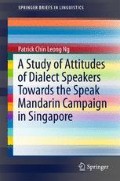Abstract
The SMC is the longest campaign held in Singapore, spanning more than 30 years since it was initiated in 1979. In an attempt to persuade dialect speakers to embrace Mandarin, the Singapore Government proposed three official arguments for the implementation of the campaign: the education, communicative, and cultural argument. Various campaign strategies were adopted to promote Mandarin. In the first phase of the campaign, from 1979 to 1989, the main strategy adopted by the SMC was to eradicate Chinese dialects in Singapore. Chinese dialects were banned in mass media such as television. The campaign also made use of several campaign slogans such as “Speak More Mandarin and Less Dialect” to persuade Chinese Singaporeans to discard dialects and switch to speaking Mandarin. This chapter reviews the literature on the SMC. The chapter opens with an explanation of the organization of the SMC. Next, it describes the measures undertaken by the government to implement the campaign. It then proceeds to examine some impacts of the SMC.
Access this chapter
Tax calculation will be finalised at checkout
Purchases are for personal use only
References
Ang, B. C. (1998). The teaching of the Chinese language in Singapore. In W. K. Ho, S. Gopinathan, A. Pakir, H. W. Kam, & V. Saravanan (Eds.), Language, society and education in Singapore: Issues and trends (pp. 335–352). Singapore: Times Academic Press.
Bokhorst-Heng, W. (1998). Language planning and management. In J. A. Foley (Ed.), English in new cultural contexts (pp. 287–309). Singapore: Oxford University Press.
Bokhorst-Heng, W. (1999). Singapore’s Speak Mandarin Campaign: Language ideological debates in the imagining of the nation. In J. Blommaert (Ed.), Language ideological debates (pp. 235–266). New York: Mouton de Gruyter.
Chiew, S. K. (1980). Bilingualism and national identity: A Singapore case study. In A. Afendras & E. Kuo (Eds.), Language and society in Singapore (pp. 233–253). Singapore: Singapore University Press.
Gopinathan, S. (1979). Singapore language policies: Strategies for a plural society. Southeast Asian affairs (pp. 280–295). Singapore: Institute of Southeast Asian Studies.
Gupta, A. (1994). A framework for the analysis of Singapore English. In S. Gopinathan et al. (Eds.), Language, society and education in Singapore (pp. 119–132). Singapore: Times Academic Press.
Gupta, A. (1998). A standard for written Singapore English? In J. Foley (Ed.), English in new cultural contexts (pp. 75–99). Singapore: Oxford University Press.
Gupta, A. F., & Siew, P. K. (1995). Language shift in a Singapore family. Journal of Multilingual and Multicultural Development, 4(16), 301–313.
Ho, C. L., & Alsagoff, L. (1998). English as the common language in multicultural Singapore. In J. Foley (Ed.), English in new cultural contexts (pp. 201–217). Singapore: Oxford University Press.
Kuo, C. Y. E. (1985). A quantity approach to the study of sociolinguistic situation in multi-linguistic society. Singapore: Regional English Language Centre.
Kuo, E. C., & Jernudd, B. H. (1988). Language management in multilingual state: The case of planning in Singapore. Working Papers. Faculty of Arts and Social Sciences. Department of Sociology. National University of Singapore.
Lee, K. Y. (2011). My lifelong challenge: Singapore’s bilingual journey. Singapore: Straits Times Press.
Newman, J. (1988). Singapore’s speak Mandarin campaign. Journal of Multilingual and Multicultural Development, 9(5), 437–448.
Platt, J. (1980). Multilingualism, polyglossia, and code selection in Singapore. In E. A. Afendras & E. C. Y. Kuo (Eds.), Language and society in Singapore (pp. 201–217). Singapore: Singapore University Press.
PuruShotam, N. C. (1998). Negotiating language, constructing race. New York: Mouton de Gruyere.
Shepherd, J. (2003). Striking a balance: The management of language in Singapore. Berlin: Peter Lang.
Wong, W. K. (2011). Census of population 2010. Singapore: Department of Statistics.
Author information
Authors and Affiliations
Corresponding author
Rights and permissions
Copyright information
© 2017 The Author(s)
About this chapter
Cite this chapter
Ng, P. (2017). Review of Literature on the Speak Mandarin Campaign (SMC). In: A Study of Attitudes of Dialect Speakers Towards the Speak Mandarin Campaign in Singapore. SpringerBriefs in Linguistics. Springer, Singapore. https://doi.org/10.1007/978-981-10-3443-5_4
Download citation
DOI: https://doi.org/10.1007/978-981-10-3443-5_4
Published:
Publisher Name: Springer, Singapore
Print ISBN: 978-981-10-3441-1
Online ISBN: 978-981-10-3443-5
eBook Packages: Social SciencesSocial Sciences (R0)

